Laptop Graphics Face Off: Diablo III Performance
by Jarred Walton on May 26, 2012 4:25 AM ESTDetailed FRAPS Runs and Closing Thoughts
For those of you that want a different view of the gaming action, we’ve selected the highest quality but still playable result for each GPU. In general, that means we wanted average frame rates of 25 or higher, with minimum frame rates always above 15 FPS. Obviously you could tweak settings in other ways and still get playable results (e.g. by dropping the resolution, you might be able to run our Enthusiast settings at 1366x768 instead of Mainstream 1600x900), but we’ve stuck with our three basic categories for the following charts. We’ve ordered them in terms of increasing performance/quality.
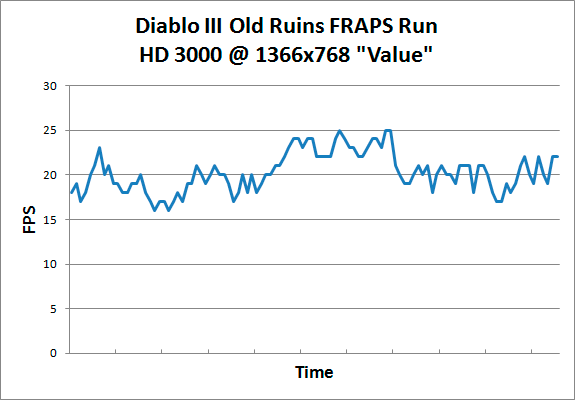
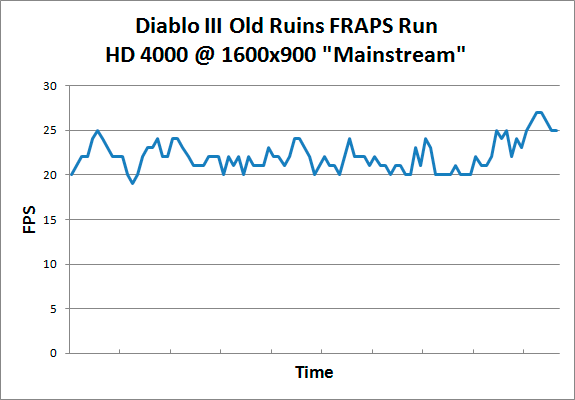
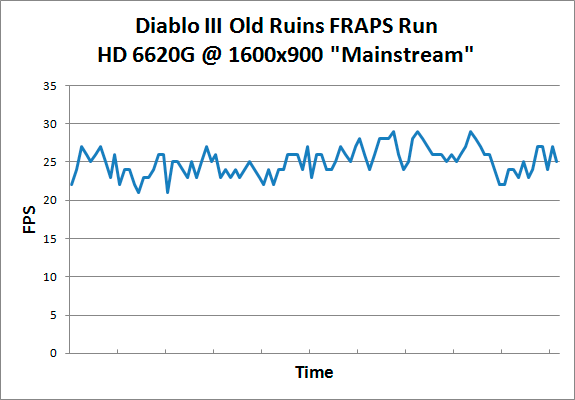

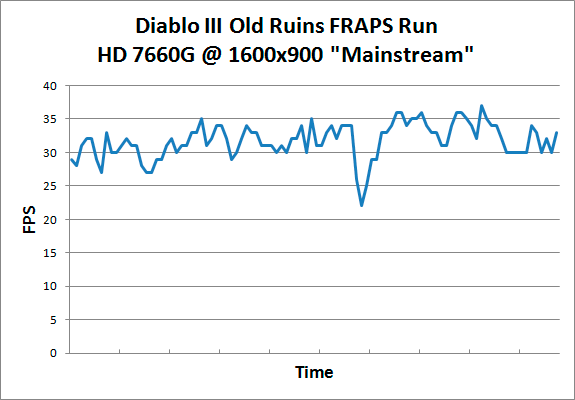

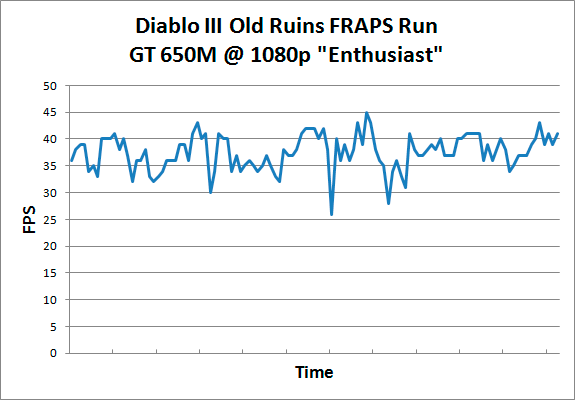
Given what we’ve said already, your best results will generally come by keeping minimum frame rates above 20. Assuming there are other segments of the game that will be more taxing than our benchmark sequence, you might still drop into the upper teens, but as long as you’re above 15 FPS you shouldn’t “lose sync”. Even at our Value settings, HD 3000 is already dangerously close to dropping below 15 FPS at times; you might have to give up on Shadows altogether to get acceptable performance. HD 4000 at our Mainstream settings ends up staying above 20 FPS for the most part but rarely gets above 25 FPS; by comparison, Llano’s HD 6620G ranges from around 22 FPS to nearly 30 FPS. For a smoother experience, though, you’ll still want 30 FPS or more, and that’s where the HD 6630M and Trinity’s HD 7660G fall, with Trinity averaging just slightly better performance despite one large dip to the low 20s.
As shown in our earlier charts, the real winner in terms of gaming performance looks like NVIDIA, though the use of Ivy Bridge CPUs for our two fastest test laptops leaves room for debate. The Acer doesn't appear to have any real issues with throttling in this game, however, despite my earlier fears; it looks like Diablo III (at least early on) just doesn't tax the CPU enough to routinely need more than a moderate 1.2-1.6GHz on the i5-2410M. The 15~20% performance advantage of the N56VM over the 3830TG instead comes from a higher clocked GPU, despite earlier indications that the opposite was the case.
Closing Thoughts
Wrapping up, while Diablo III isn’t the most demanding new release, it can still bring basic laptops to their knees. Unfortunately, unlike desktops it’s often not possible (or at least not practical) to upgrade a laptop’s graphics capabilities. I’ve had a couple friends ask for help with running Diablo III on their old Core 2 Duo laptops, and they’re basically out of luck unless they want to purchase a new system. That’s something we’ve tried to explain in our laptop reviews, and Diablo III drives the point home: buying at the bottom of the barrel in terms of GPU capabilities may not matter for you right now, but kids and/or future applications may eventually make your IGP-only laptop insufficient.
In the case of Diablo III, even a moderate HD 3650 or GT 330M should still be able to handle the game in single player on Normal difficulty, but IGP solutions from two or more years back are likely going to come up short. Naturally, anything faster than the GPUs we’re testing here will allow you to increase details/resolution, and it’s nice to see “mainstream” mobile GPUs like the GT 540M/GT 630M able to handle 1080p gaming for a change.
And again, in case you missed it, the later stages of the game, particularly on Hell difficulty level, are said to be quite a bit more strenuous. If you're the type of player that intends to defeat Diablo not once but three or more times at increasingly difficult settings, our results from early in the game are probably not representative of what you'll experience later. Performance does appear to stay relatively consistent among the various GPUs, though, so if you take half of our performance results as a baseline of what to expect, you're probably not far off the mark.










87 Comments
View All Comments
JarredWalton - Friday, June 1, 2012 - link
Anand commented to me the other day that "Windows HD 4000 results are faster than MBP15 with dGPU results", if that's anything to go by.Patflute - Saturday, May 26, 2012 - link
...DanNeely - Saturday, May 26, 2012 - link
Some people are severely space limited; others are casual gamers and don't play enough to justify having two computers. As a very mass market game; DIII will be selling a huge number of copies to people in the latter group.kyuu - Saturday, May 26, 2012 - link
Many people have both laptops and desktops, and regardless of the desktop obviously being superior for gaming, they'd still like to be able to game a bit on their laptop when they're out and about and don't have access to their desktop.Then, there are people who don't have the space for a desktop, or simply prefer the freedom of being able to move around their home but would still like to play games.
The question is, why do other people's usage models bother you so much? You don't care about the gaming ability of laptops. Fine. Don't pay attention to articles about it. Meanwhile, there are plenty of others, such as myself, who are highly interested.
frozentundra123456 - Saturday, May 26, 2012 - link
I am confused about the GT540M vs the GT630M. Isnt the GT630m just a re-badged GT540m with higher clocks? Or is it the new G-force architecture? I believe only the 640M and above have the new architecture.JarredWalton - Saturday, May 26, 2012 - link
The GT 630M is technically a straight up rebadge of GT 540M. However, the GT 630M in the ASUS N56VM that we have shows clocks that are quite a bit lower than other GT 540M GPUs. Strangely, those lowered clocks don't appear to matter much in Diablo III, so either NVIDIA's control panel (and GPU-Z) are reporting incorrect information, or the shader cores aren't as demanding as you might expect.frozentundra123456 - Saturday, May 26, 2012 - link
You did say the acer was running hot. Maybe the cpu/gpu was throttling due to temps. Or maybe the quad core in the Acer made a difference (not likely?).JarredWalton - Saturday, May 26, 2012 - link
Correct. The Acer is definitely not hitting Turbo speeds, let along the base 2.3GHz clock. So the combination of faster CPU + slower GPU works out in favor of the N56VM in this instance. I really wish I had a good way to test the N56VM with the fully clocked GT 540M, though.Arcquist - Saturday, May 26, 2012 - link
Google 'ThrottleStop'. Many of the Acer Aspire users that experience throttling problems in games use it to prevent the under-clocking. Note it will get hot though and you might want to raise the back of the laptop off the desk with a binder or something to improve airflow (intake).JarredWalton - Sunday, May 27, 2012 - link
Funny enough, I actually reran tests with ThrottleStop already and it just didn't seem to help. I'm not sure what's going on, but even with TS enabled and set to a 20x (or 21, 22, 23, Turbo) multiplier, the system still seems to just plug along at the 800-1500MHz range during testing. I've done everything I know of to make it run faster, and it just doesn't seem to matter. But this particular laptop has always been a bit quirky; I might try looking for a new BIOS again just to see if anything has changed, but I doubt it.